How to Visit Salinas Grandes in 2024: Top 15 Questions Answered

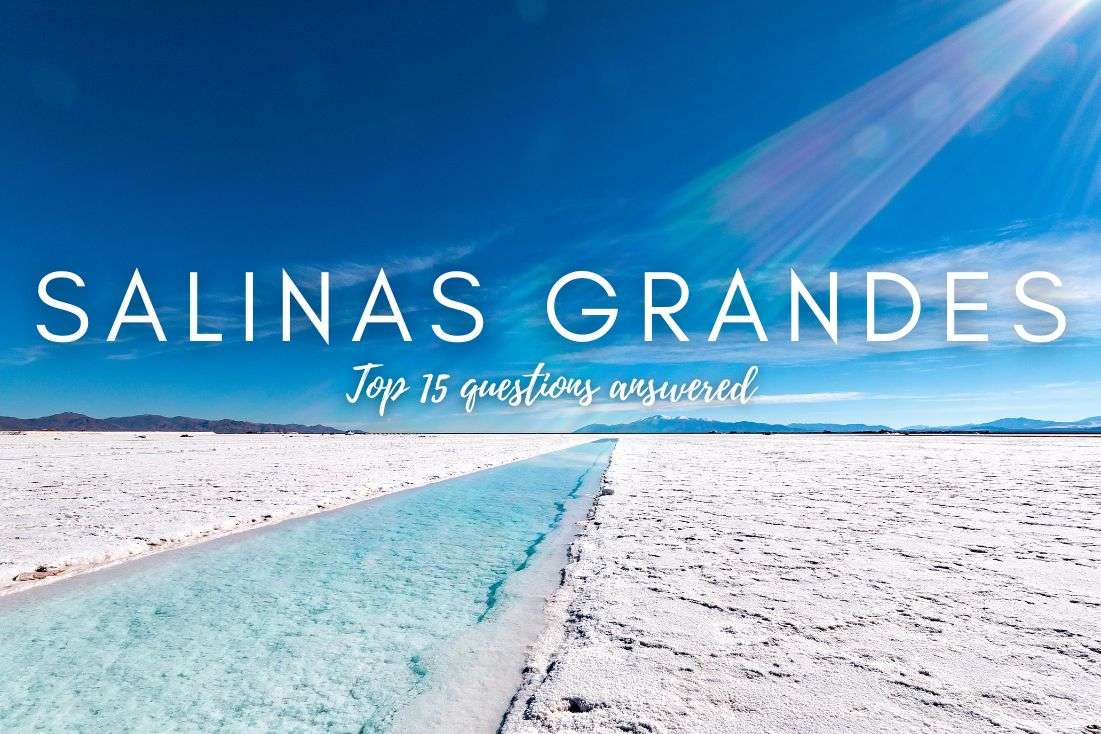
Argentina is, without a doubt, a treasure chest brimming with natural wonders begging to be visited. And let me tell you, Salinas Grandes is a gem that shines bright on this list!
I could go on about how you won't find such a place anywhere else in the world, but I bet some of you might raise an eyebrow. Sure, salt flats can be found in other countries. Take Bolivia's Salar de Uyuni, for example, the largest salt flat in the world, or the famous Death Valley in the USA. Yet, each of these salt plains has something special about it and boasts a unique atmosphere, despite being just a salty, flat area. So, I'm sticking to my guns on this one.
If this isn't the first article of mine you're reading, you probably know by now that I'm a fanatical planner who loves to have all the necessary details figured out in advance. That's not always possible, though, so sometimes I have to dive into the unknown and figure things out as I go. But it's exactly because of this that I can provide you with the most up-to-date and detailed information, helping you plan your trip with ease.
The same goes for a trip to Salinas Grandes. In this article, you'll find all the crucial information you need to know before you decide to witness this unique place with your own eyes.
1. What is Salinas Grandes?
Salinas Grandes are Argentina's most famous salt flats, covering a whopping 6,000 km² (about 2,300 square mi). That's a lot of ground, but they're still playing second fiddle to Bolivia's Salar de Uyuni, which stretches over 10,582 km² (about 4,086 square mi).
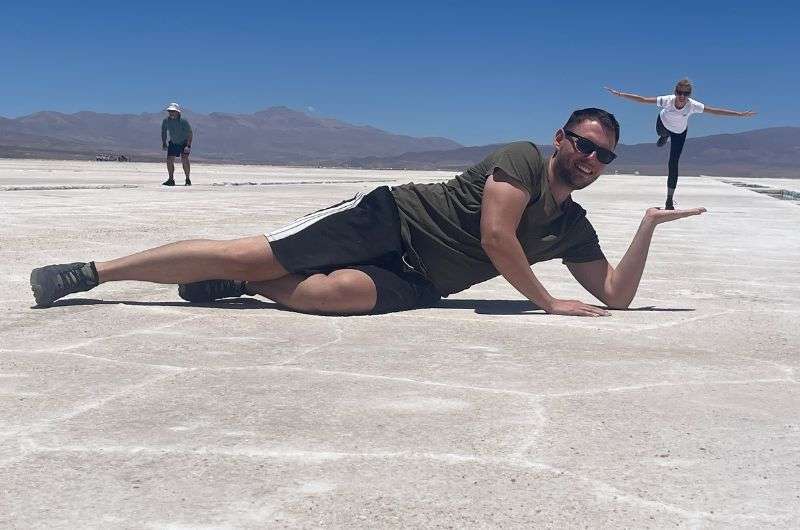
Am I huge or is she small?!
But here's the kicker: Salinas Grandes sits at an elevation of 3,450 m (around 11,318 ft) above sea level. Yeah, we're talking sky-high, folks, so much so that acute mountain sickness could become your unwanted travel buddy starting around 3,000 m (about 9,842 ft). It's not the least bit fun, so if you start feeling sick, tired, and headachy, you'll need to head down to lower elevations.
This is one visit you're not likely to forget anytime soon. I've been around the block a few times (as you, my dear loyal followers, well know), but the Salinas Grandes salt flats really made an impression on me. It feels like stepping into another dimension, surrounded by a vast expanse of white salt crust underfoot.
And get this: there's water underneath that salt, meaning you could theoretically break through the salt into the super salty water below. It's not like accidentally over-salting your pasta water at home; dip your hand in this water, and it feels like you've plunged it into oil. If you’ve ever been to the Dead Sea, you’ll know what I mean. The real deal here is that salt is mined, creating these incredible plains. I mean, just take a look at these photos and tell me it's not a one-of-a-kind place.
Find an awesome hotel Sometimes, all you need to do is take the first step... I've filtered out the best hotels in San Salvador de Jujuy for you
Save it for yourself to come back to later, or share with your friends on social media!
I've already planned your ititnerary for the trip, complete with my travel tips.
2. Where is Salinas Grandes located?
Salinas Grandes is perched up north in Argentina, straddling the border between the Jujuy and Salta Provinces. The closest town is Purmamarca, roughly 68 km (about 42 mi) away from the salt flats, though it's more of a quaint village vibe there. Then there's the larger city, San Salvador de Jujuy, sitting about 130 km (approximately 81 mi) away.
3. When to visit Salinas Grandes?
You can hit up Salinas Grandes any time of the year. Personally, I recommend swinging by during the dry season, which lasts from May to December. The landscape is parched, and it's not cold. Expect some significant temperature swings from day to night at Salinas Grandes, with daytime temps hovering around 28°C (82°F) and night temps ranging from around 0°C (32°F) to 10°C (50°F).
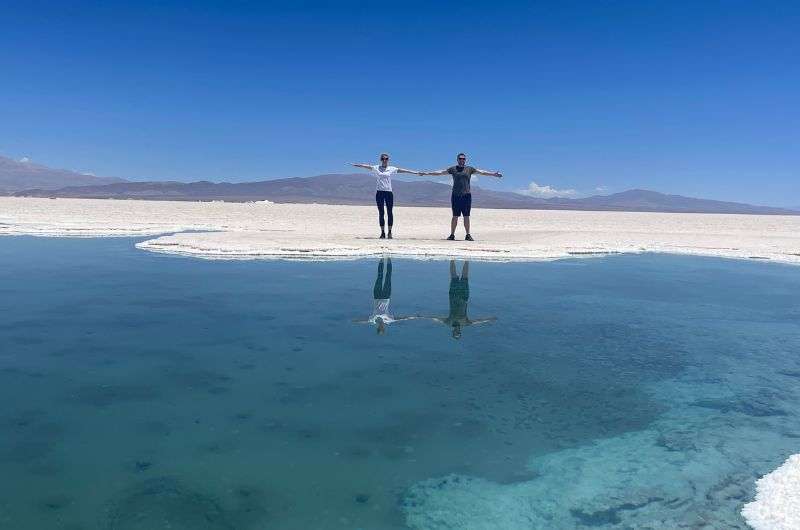
We went to Salinas Grandes in the dry season
During the rainy season, it's cooler, so the best time to visit is between 12 pm–4 pm when it's warmest. Just so you know, nighttime temps can dive below freezing, and it can get pretty windy, so pack a windbreaker. Despite it being the rainy season, it doesn't actually pour much—annual rainfall amounts to about 300 to 400 mm (11.8–15.7 in). The water creates a mirror-like reflection on the salt's surface, making it look like you're walking on clouds in photos, which might make a rainy season visit worth considering.
4. Can you drive to Salinas Grandes?
Yes, you can totally drive to Salinas Grandes. From what I gathered from the locals, it used to be a 4x4-only situation, but times have changed, and now there's a pretty smooth road leading to Salinas Grandes.
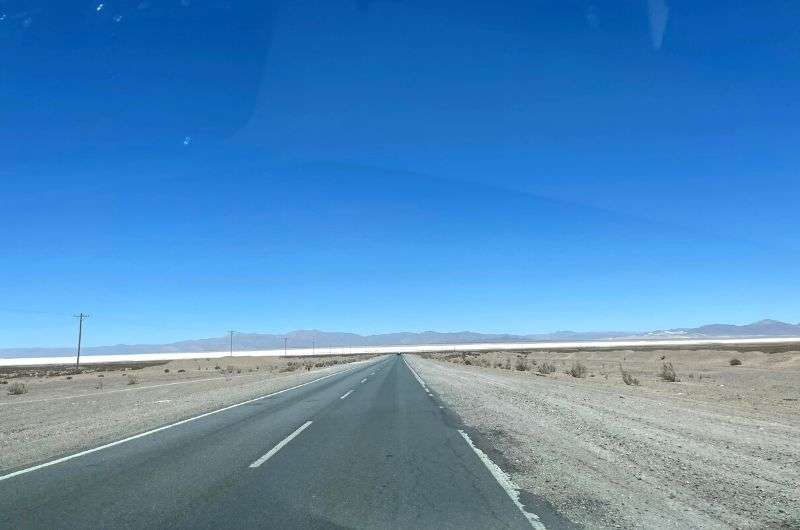
As always on my trips, I rented a car for my visit to Salinas Grandes
If you're thinking of saving some bucks and renting something small like a Fiat 500, I've got good news for you. I've seen folks there in similar rides. But I'd still lean towards renting something with a bit more oomph. You're heading into high altitudes where the air is thinner, and combustion engines lose some of their kick. Plus, bigger cars offer more comfort. Actually, you'll also be driving your car right into Salinas Grandes! You need to have a guide, but it's essentially a self-drive kind of deal.
5. Can you go to Salinas by public transport?
Yep, it's totally doable to get to Salinas Grandes via public transport. Personally, I wouldn't go that route. But you can "comfortably" make your way there from either Salta or San Salvador de Jujuy. I've dived into more detail on this in questions 6 and 7.
Here's a little tip from me to you: rent a car and cruise on your own terms. You'll save time, spare yourself some stress, and if something catches your eye along the way, you can just pull over and soak it in.

Flor Del Pago is the perfect dining stop—a rare find in Argentina!
You might want to make a pit stop at Flor Del Pago restaurant. It's up there among the finest dining spots I've been to on my globetrotting adventures. That's quite the statement because, between you and me, finding a decent restaurant in Argentina is like looking for a needle in a haystack. It's not quite the culinary wasteland that Georgia is, but Argentina is running a tight second. Flor Del Pago is the exception that proves the rule, though. The service is top-notch, quick, and not overbearing. The food is out of this world, especially the ceviche, all set against a beautiful colonial backdrop. Plus, there's ample parking and a fantastic garden to boot.
6. How to get from Salta to the salt flats (Salinas Grandes)?
The easiest way to get from Salta to Salinas Grandes is by car. In Salta, you can rent a car, and from there, it's about a 4-hour drive (taking the more boring but shorter route).
Or, you can opt for the longer route, see the map, which takes about 45 minutes longer but offers stunning views. Don't worry, the journey is comfortable and smooth.
Here is the road from Salta to Salinas Grandes (check the Google Maps)
As you probably know, I steer clear of public transport, so I didn't explore this option for myself, but I've dug up the details for you. The bus journey is a bit more complicated and requires a bus change. From Salta, you need to head to the city of San Salvador de Jujuy. The trip takes around 2.5 hours. Once you disembark, you'll catch a bus to Salinas Grandes, a 3-hour ride. Total travel time, including the transfer, is about 6 hours. Ouch!
Buses run just once a day, so if your first bus gets delayed, you might have to spend the night in San Salvador de Jujuy (here are the best things you can do there to pass the time). Or hitchhike, haha, which is pretty doable in South America. Best of luck.
Tip: The Salta and Jujuy provinces have a lot to offer (check out my article about Salta and Jujuy highlights), so if I were you, I'd stay in the city for a few days on purpose, not just because the bus was late, and explore other attractions the area has to offer. Personally, I recommend the MG Design Hotel Boutique, just a few meters from the city center. The hotel is modern, and the rooms are really spacious—I hate it when I can barely turn around in a room. And, of course, the breakfast is fantastic.
7. How to get from San Salvador de Jujuy to Salinas Grandes?
Again, the simplest way is by car. The journey isn't particularly challenging and takes about 2 hours. Another option is a taxi, which will take about the same amount of time (surprisingly) and will cost you ARS 5,600 (USD 7).
Here is the shorter option from San Salvador to Salinas Grandes (check the Google Maps)
Just like if you were setting off from Salta, you also have the option to take a bus from San Salvador. The bus also runs just once a day and the journey takes about 3 hours, but the upside is that you don't need to transfer. Whether the buses are comfortable and have air conditioning I can't tell you. I haven't taken the bus in Argentina, so feel free to let me know how it was. I’ll still drive though.
8. How long does it take to visit Salinas Grandes?
You can spend anywhere from 1 to 3 hours at Salinas Grandes. Personally, I hung out for an hour, but if you're on a mission to make your Instagram followers green with envy, you'll likely stick around longer. There are plenty of salt pools to explore. Here, salt crystallizes directly from the water, much like the Dead Sea. It's a fascinating process. If you're lucky, you might catch locals harvesting salt. Quite the sight to see.
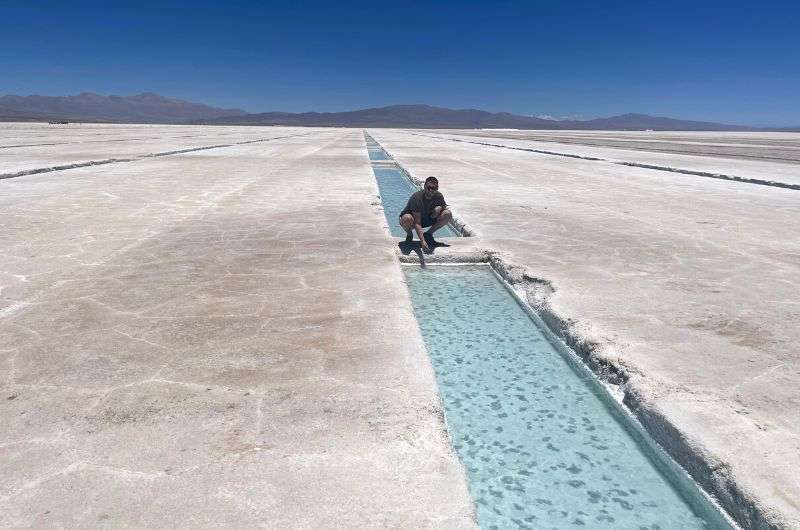
Yep, and then I touched my eye...
Now, let's talk about the Ojos de Salar—these natural springs are like the Earth popping a cold one, creating these insanely clear saltwater lakes. If you dip your feet or hands in these lakes, expect them to turn snow-white with salt. And, a word to the wise: don't touch your eyes afterward (don't ask me how I know this).
9. Do you need a guide to Salinas Grande? (How much does it cost?)
You absolutely need a guide in Salinas Grandes. And this time, it's not just one of my hearty recommendations, but rather because you literally won't be allowed in without a guide.
So here's the deal: we went for the self-drive option, which, in my humble yet highly experienced opinion, is the fastest and most comfortable way to roll. We didn't pre-book a guide or anything fancy like that. Instead, we just showed up, and bam, made arrangements on the spot. There are plenty of guides around, so it was a breeze. The price? A cool ARS 5,000 (that's around USD 6) per car, and here's how it goes down: you're in your car, and the guide is zooming ahead on a motorcycle.
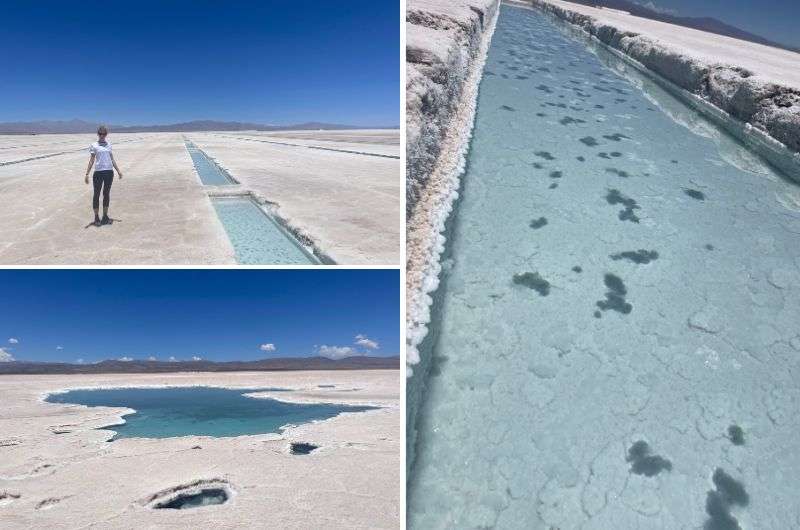
You can’t go to Salinas Grandes without a guide. But they mostly let you do your thing, like getting all those forced perspective photos
From what I could tell, about half the folks there did it the same way we did, but of course, that's not the only way to go. If rolling with a crowd is more your jam, you can totally go the organized tour route. The web's crawling with tours kicking off from San Salvador de Jujuy or Salta. Most of these are day trips with a pit stop in Purmamarca, but you can also find two-day adventures.
10. Can you walk in Salinas Grandes?
Yes, you can walk in Salinas Grandes. There are spots where you're free to wander, leap over little salt pools, and snap pics to your heart's content. But, heads up, there are some ground rules on the way to the Ojo de Salar. Due to the fragile nature of the salt crust, you gotta line up in single file. No sweat, though; they'll break it all down for you on-site. But getting that perfect shot might be a bit tricky since you can't just roam and pose wherever you fancy.
11. What is Salinas Grandes known for?
Well, it's one of the largest salt flats in South America, for starters. But wait, there's more. Salinas Grandes is also a prime spot for salt mining. The salt harvested here goes towards a slew of uses, from making chlorine and sodium hydroxide to spicing up your dinner and even softening water.
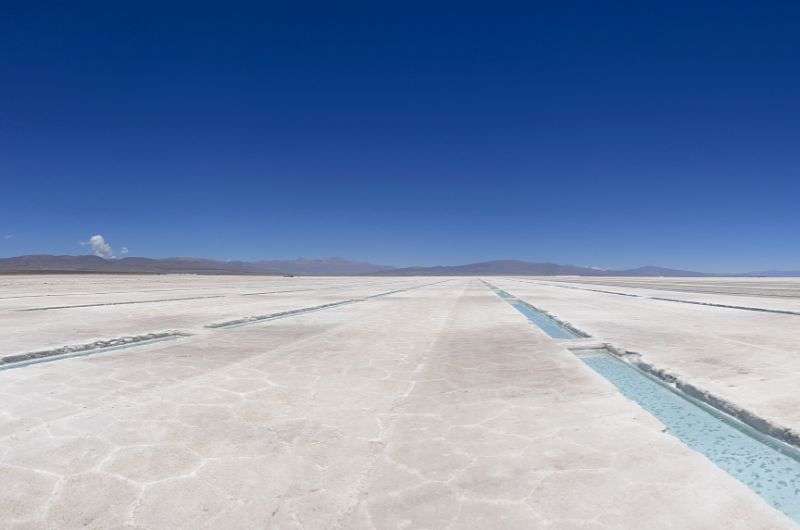
One of the largest salt flats in South America
Fun fact: The area around Salinas Grandes is home to indigenous communities that have been living and thriving here for centuries. These folks protect, care for, and mine salt from the land. The entry fee you pay? That goes right back to them. They've got traditional ways of living and are all about harmony with nature.
12. How high is Salinas Grandes?
Salinas Grandes sits at an elevation of 3,450 m (11,318 ft) above sea level. Coming from a place where the tallest peak is just 1,602 m (5,256 ft), I gotta say, that's pretty darn impressive. But, in the altitude competition, Salinas Grandes doesn't snag the top spot. Yup, you guessed it, Salar de Uyuni takes the cake again, perched at 3,656 m (11,995 ft) above sea level. Make sure to read up on altitude sickness before you go.
13. How were the Salinas Grandes formed?
So, the Salinas Grandes popped up thanks to a bunch of geological shenanigans that went down over millions of years (think 5 to 10 million years back). Picture this: an area that was once an ancient seabed gets hit with a mega drought, causing all that water to evaporate and leave behind a crusty layer of salt—and voila, a tourist hotspot is born. Just imagine, the salt crust is about 1 meter deep (about 3 feet). Just imagine the insane amount of time it took for all that salt to settle!
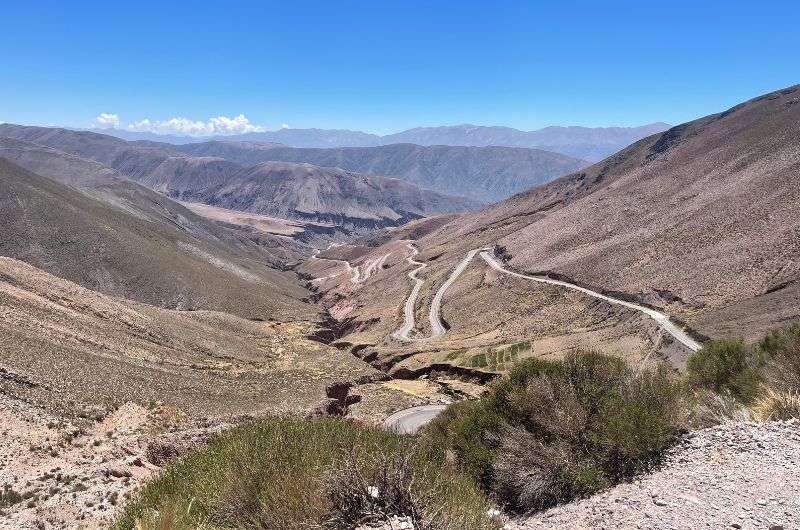
Salinas Grandes is actually a dry seabed
Fun fact time: Ever wonder how those perfectly regular cracks and geometric shapes, especially those hexagonal patterns, show up on the salt flats? No? Well, I didn't either until I found out. For the longest time, it was a head-scratcher why the surface of salt flats would sport these neat geometric forms. Turns out, it’s all because the water on the surface gets saltier (and heavier) as it evaporates, sinking down while the less salty (lighter) water rises. This creates convection cells, and those cells give us those neat patterns. Mystery solved!
14. What is the difference between Uyuni and Salinas Grande?
The main difference between Uyuni and Salinas Grande boils down to their location. While Uyuni is in Bolivia, Salinas Grande struts its stuff in Argentina. Size-wise, Uyuni is the heavyweight champion, clocking in at roughly twice the size of Salinas Grande and snagging the title for the world's largest salt flat. And just when you thought it couldn't get any higher, Uyuni sits about 200 m (656 ft) higher than Salinas Grandes, claiming the altitude crown too. But, silver lining for Salinas visitors—you're less likely to get that head-throbbing altitude sickness there.
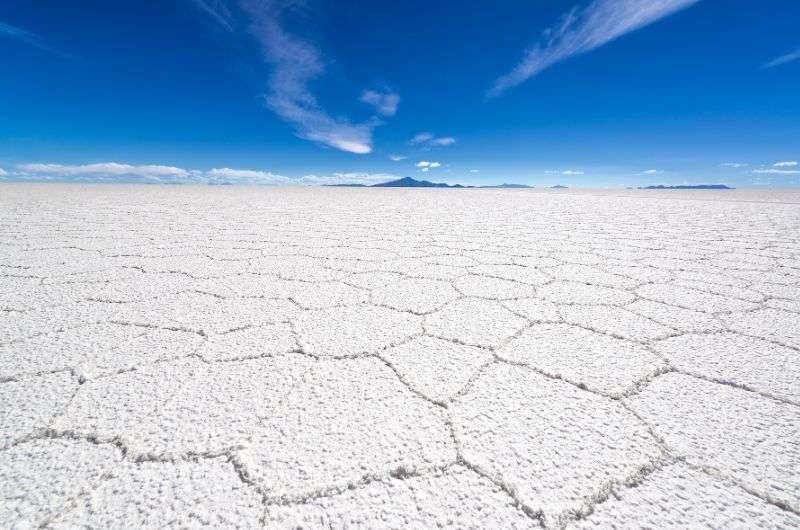
Bolivian Uyuni—the largest salt flat in the world
If you find yourself in Argentina and itching for a salt flat adventure, you might ponder making the trek to Uyuni. But brace yourself, it's not a day trip; it's a mini expedition. So, I whipped up a no-brainer rule to help you decide which salt flat to visit: If you're chilling in Bolivia, hit up Uyuni. If Argentina's your playground, then Salinas Grande is your go-to. Bet you didn't see that coming, huh? I know, genius.
15. What does Salinas Grandes mean in English?
"Salinas Grandes" translates to "Great Salt Flats" in English. The name, as you might guess, comes from Spanish, which is the official language in Argentina, as well as in many other South American countries. Following the discovery of the Americas, overseas expeditions gradually colonized South America. Argentina fought for and gained its independence in 1816. Just a little tidbit for you to round out the general picture.
Find an awesome hotel Sometimes, all you need to do is take the first step... I've filtered out the best hotels in San Salvador de Jujuy for you
Save it for yourself to come back to later, or share with your friends on social media!
I've already planned your ititnerary for the trip, complete with my travel tips.
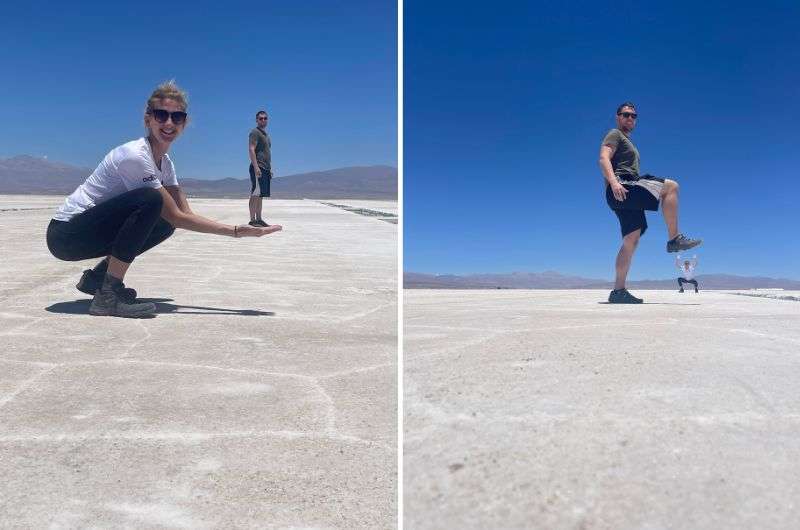
I knew we needed lots of these forced perspective pics! I have to say the tourists all look ridiculous taking these photos
You might also be interested in reading:
The best 2-week itinerary for Argentina
Patagonia Travel Guide: 7 Days of Exploring El Chaltén and El Calafate
How to plan a trip to Iguazu Falls (3-day plan)
12 epic day hikes in Argentina of all difficulty levels
27 fun facts and travel tips for Argentina
This post contains affiliate links. I earn a small commission if you make bookings through my links, at no additional cost to you. Thank you for your support!





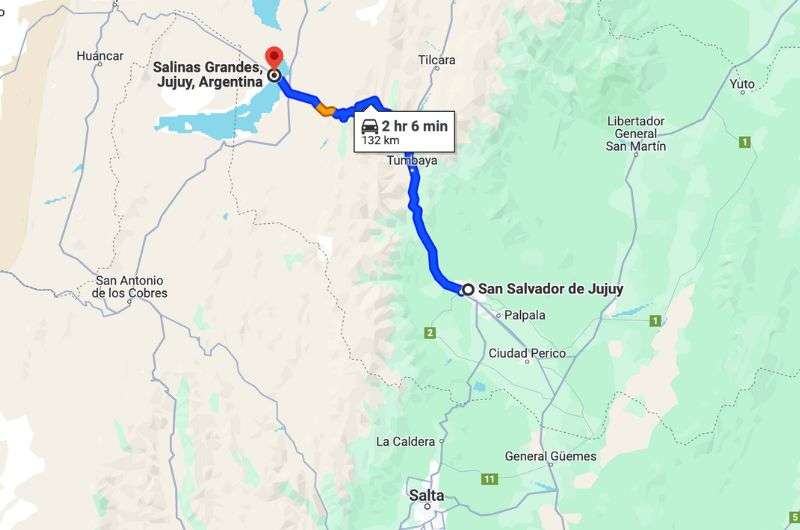

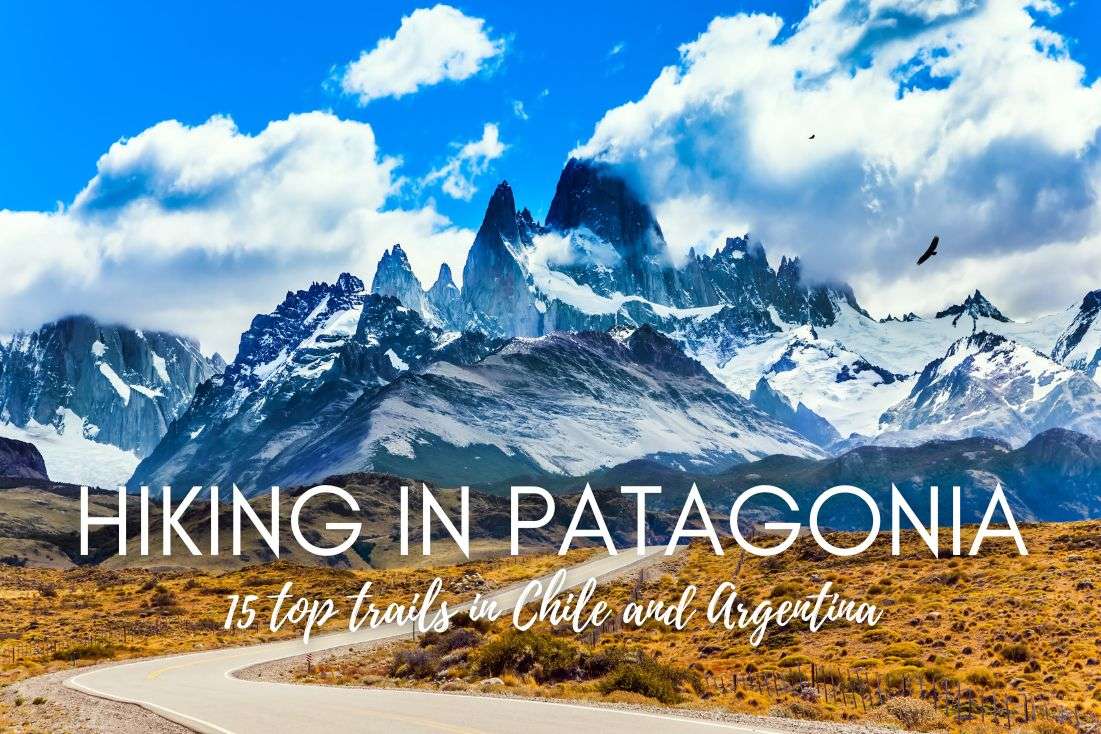




Comments | Thoughts? Give us a shout!